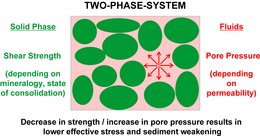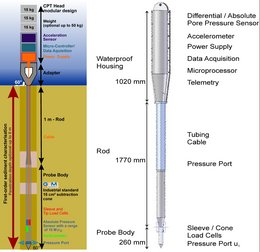Page path:
- Home
- Sylvia Stegmann
Dr. Sylvia Stegmann |
|
|
Research Staff |
|
|
Group: |
Science Communication |
|
Phone: |
|
|
Email: |
|
|
Room: |
MARUM UNISchullabor |

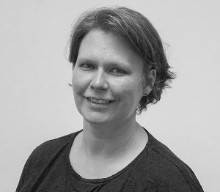
Curriculum Vitae
| May 2008 | Annetee-Barthelt-Preis |
| 2007 - now | Post-Doc Marine Geotechnics / MARUM University of Bremen |
| 2004 - 2007 | PhD Student at Research Center Ocean Margin (RCOM) in Marine Geotechnics “Development of a marine free fall CPT for geotechnical measurements of (strength and pore pressure) of marine sediments.” |
| 2004 | Diploma (=MSc): Side-scan sonar mapping of fluvial sediments in the Weser estuary and their dynamics |
| 2001 - 2004 | Physical Geography w/ focus on Marine Geology, University Bremen |
| 1998 - 2001 | Physical Geography w/ focus on Physics and Remote Sensing / Ludwig-Maximilian University (LMU) Munich |
| 1997 - 1998 | Social Geography / Technical University Munich (TUM) |
Scientific interest
Sedimentary stability is a controlling factor for denudative and tectonic processes.
Marine sediments consist on grains (solid phase) and fluids (water, gas) in between the pore space, which depends on the compaction of the sediment. An increase of consolidation means a reduction of pore space. If during compaction an adequate drainage is not allowed, overpressured sediments occur. Geological processes causing overpressuring are (i) high rates of sedimentation in fjords, estuary, deltas or deep-sea trenches, (ii) tectonic, tidal, glacial loading, (iii) dissociation of gas hydrates, (iv) groundwater flow and/or (v) dehydration of minerals. Overpressure produces a decrease of effective stress, which may be result in destabilisation of the sediments. In addition to pore pressure, sedimentary strength (as a function of mineralogical composition) is a controlling parameter, which defines soil stability.
At the MARUM, we developed two marine free-fall penetrometer, which can be operated in 200 m (shallow-water lance) and up to 3200 m (deep-water lance) waterdepth, to measure the stiffness and pore pressure of marine sediments in situ. Both instruments are based on standard industrial 15cm²-CPT cones. During insertion of the lance, sedimentary force, acting against the lance, cohesion (cone resistance, sleeve friction) and ambient pore pressure (=measured pressure – (hydrostatic + lithostatic pressure)) are profiled. Dissipation of pore pressure after insertion of the probe can be observed. These measurements can be used to derive crucial geotechnical parameters, e.g. undrained shear strength, permeability.
The shallow-water lance is characterised by its modular concept, which allows a variation of the length with 1m-extension rods up to 6.5m as well as of the weight with 15kg-pieces (40kg-170kg). Depending on the sediment different penetration depth can be reached. This relative easy-handling tool can be deployed from different platforms without an huge effort, including also long-term measurement up to 12 hours.
According to the required period for deep-sea applications, the deep-water lance is operated via telemetry, which provides a realtime-data-transfer and power supply. This probe is equipped with a differential pore pressure system with pore pressure ports directly on the cone and 60 cm above.
Marine sediments consist on grains (solid phase) and fluids (water, gas) in between the pore space, which depends on the compaction of the sediment. An increase of consolidation means a reduction of pore space. If during compaction an adequate drainage is not allowed, overpressured sediments occur. Geological processes causing overpressuring are (i) high rates of sedimentation in fjords, estuary, deltas or deep-sea trenches, (ii) tectonic, tidal, glacial loading, (iii) dissociation of gas hydrates, (iv) groundwater flow and/or (v) dehydration of minerals. Overpressure produces a decrease of effective stress, which may be result in destabilisation of the sediments. In addition to pore pressure, sedimentary strength (as a function of mineralogical composition) is a controlling parameter, which defines soil stability.
At the MARUM, we developed two marine free-fall penetrometer, which can be operated in 200 m (shallow-water lance) and up to 3200 m (deep-water lance) waterdepth, to measure the stiffness and pore pressure of marine sediments in situ. Both instruments are based on standard industrial 15cm²-CPT cones. During insertion of the lance, sedimentary force, acting against the lance, cohesion (cone resistance, sleeve friction) and ambient pore pressure (=measured pressure – (hydrostatic + lithostatic pressure)) are profiled. Dissipation of pore pressure after insertion of the probe can be observed. These measurements can be used to derive crucial geotechnical parameters, e.g. undrained shear strength, permeability.
The shallow-water lance is characterised by its modular concept, which allows a variation of the length with 1m-extension rods up to 6.5m as well as of the weight with 15kg-pieces (40kg-170kg). Depending on the sediment different penetration depth can be reached. This relative easy-handling tool can be deployed from different platforms without an huge effort, including also long-term measurement up to 12 hours.
According to the required period for deep-sea applications, the deep-water lance is operated via telemetry, which provides a realtime-data-transfer and power supply. This probe is equipped with a differential pore pressure system with pore pressure ports directly on the cone and 60 cm above.
CPT-Expeditions
| 2007 | L'Atalante / PRISME | submarine landslide processes in the Ligurian Basin near Nice |
| 2007 | FS Meteor / M73/1 | submarine landslide processes in the Ligurian Basin near Nice |
| 2006 | FS Poseidon / POS336 | Pore pressure measurements in the Cretan Sea for landslide studies |
| 2006 | FS Planet | Physical parameters of muddy and gassy sediments in the German North and Baltic Sea |
| 2005 | FS Meteor / M66/4b | Pore pressure measurement at the chilean continental slope |
| 2005 | Lake Lucerne, (Central Switzerland) | in situ measurements of slope sediments to study slope stability |
| 2005 | Several tests in German North and Baltic Sea (brackish, marine realm and in harbours) | Investigation of the functionality of the shallow-water lance |
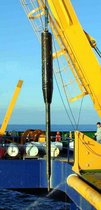
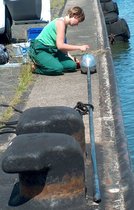
Manuscripts
- Seifert, A., Stegmann, S., Mörz, T., Lange, M., Wever, T., Kopf, A. (2008): In situ pore-pressure evolution during dynamic CPT measurements in soft sediments of the western Baltic Sea. Geo-Marine Letters, DOI 10.1007/s00367-008-0102-x.
- Stegmann, S., and Kopf, A., (subm.) Response of water-saturated sediments to pushed and free-fall Cone Penetration Tests: A comparative field study and a review. Canadian Geotechnical Journal
- Kopf, A., Stegmann, S., Krastel, S., and Förster, A. (2007). Marine deep-water Free-fall CPT measurements for landslide characterisation off Crete, Greece (eastern Mediterranean Sea) – Part II: initital Data from the western Cretan Sea, In: Lykousis, V., Sakellariou, D., and Locat, J. (Edts.) (2007). Submarine Mass movements and Their Consequences, 3rd international Symposium, Springer, Netherlands, 199-208.
- Stegmann, S., and Kopf, A. (2007). Marine deep-water Free-fall CPT measurements for landslide characterisation off Crete, Greece (eastern Mediterranean Sea) – Part I: a new 4000m cone penetrometer, In: Lykousis, V., Sakellariou, D., and Locat, J. (Edts.) (2007). Submarine Mass movements and Their Consequences, 3rd international Symposium, Springer, Netherlands, 171-177.
- Kopf, A., Alves, T., Heesemann, B., Kaul., N.E., Kock, I., Krastel, S., Reichelt, M., Schäfer, R., Stegmann, S., Strasser, M., Thölen, M. (2006). REPORT AND PRELIMINARY RESULTS OF POSEIDON CRUISE P336, Heraklion - Heraklion, 28.04. – 17.05.2006.
- Strasser, M., Stegmann, S., Bussmann, F., Anselmetti, F.S., Rick, B. and Kopf, A. (2007) Quantifying subaqueous slope stability during seismic shaking: Lake Lucerne, Central Switzerland, as model for formerly glaciated ocean margins, Marine Geology, 240, 77-97.
- Stegmann, S., Strasser, M., Anselmetti, F., and Kopf, A. (2007). Geotechnical in situ characterization of landslide deposits: The role of pore pressure transients versus frictional strength. Geophys. Res. Lett., 34, doi: 10.1029/2006GL029122.
- Stegmann, S., Moerz, T., Kopf, A. (2006). Initial Results of a new Free Fall-Cone Penetrometer (FF-CPT) for geotechnical in situ characterisation of soft marine sediments. Norwegian Journal of Geology, 86/3, 199-208.
- Stegmann, S., Kopf, A. & H. Villinger (2006). Design of a Modular, Marine Free-Fall Cone Penetrometer, A Time and Cost-Effective Device for In-Situ Geotechnical Characterization of Marine Sediments, Sea Technology 47/02, pp.27-33.
- Stegmann, S., Kopf A. & H. Villinger (2006). A new modular marine free-fall CPT, European Operational Oceanography: Present and Future, Proceedings of the 4th international Conference on EuroGOOS, pp. 150-153



